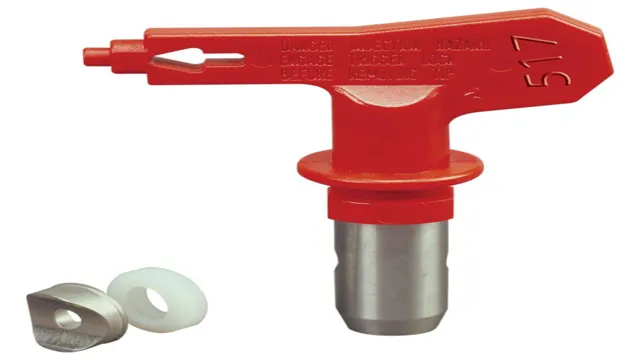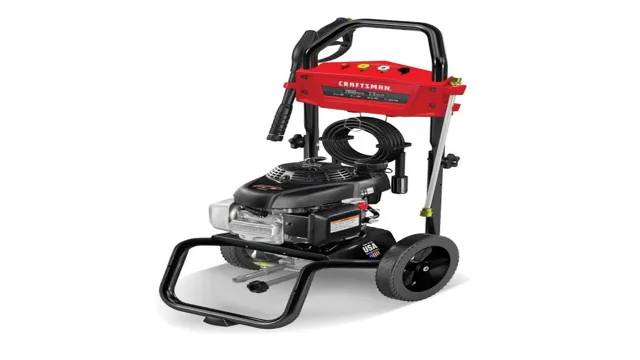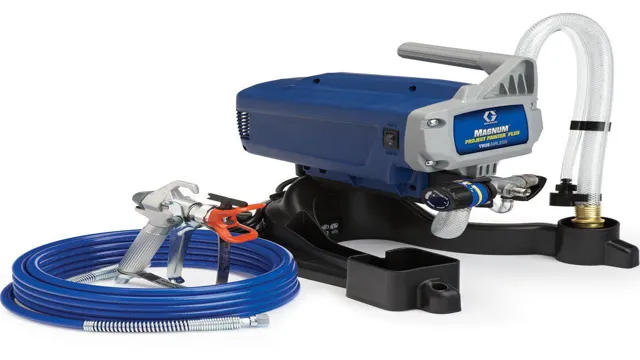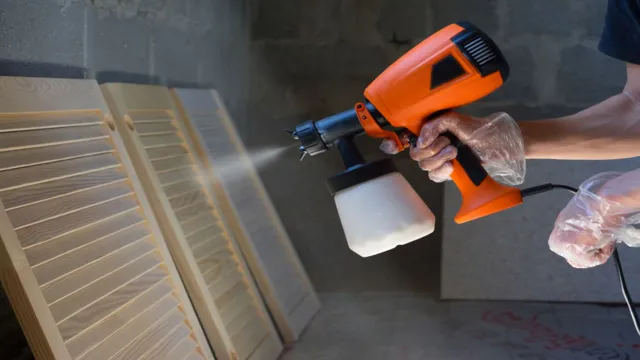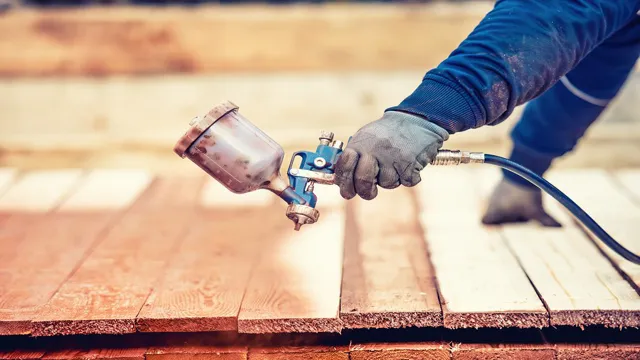How an Airless Paint Sprayer Works: A Step-by-Step Guide to Painting Perfection

Spray painting can give a new life to the worn-out, chipped, or shabby surfaces of your home or furniture. It helps to restore their beauty with a fine coat of paint, making the surfaces look brand new. Airless paint sprayers play a significant role in this process.
They are handheld painting tools that offer a much faster and efficient way of painting surfaces at home or workspaces. But how do they work? Unlike conventional paint sprayers that use compressed air to spray out the paint, airless paint sprayers use a pump to pressurize the paint and force it out through a spray gun’s nozzle. This process atomizes the paint particles, leading to a fine mist that covers the surface evenly.
Airless paint sprayers work well for large surfaces and can paint a gallon of paint within minutes. Airless paint sprayers come with different nozzle sizes that determine the size of the mist sprayed out. They are suitable for both water-based and oil-based paints and can apply thick coatings effectively.
Most importantly, airless paint sprayers can reach tiny edges and corners, making it possible to achieve a smooth and even finish on a variety of surfaces. Airless paint sprayers are versatile tools that can handle different indoor and outdoor painting tasks, including painting walls, ceilings, decks, fences, and furniture. They save time, reduce paint wastage, and produce smoother and even paint coats.
If you are looking to paint your surfaces more efficiently and achieve a professional look, airless paint sprayers are indeed a great investment.
Introduction
Are you interested in knowing how an airless paint sprayer works? Well, it’s actually quite simple! An airless paint sprayer operates by pressurizing the paint and then pushing it through a small opening at the tip of the spray gun. This creates a fine mist of paint that coats the surface evenly and smoothly. Unlike traditional spray guns that use compressed air to atomize the paint, airless sprayers rely on high pressure to break up the paint and push it through the tip.
This results in a much thicker and more consistent coating, making it the perfect choice for large projects such as exterior walls, fences, or decks. So, next time you’re faced with a big painting job, consider using an airless paint sprayer for a professional and efficient finish!
Overview of Airless Paint Sprayers
Airless Paint Sprayers Introduction: Airless paint sprayers are an efficient alternative for painting a large area more quickly than a traditional brush or roller. They use a high-pressure pump to atomize the paint, eliminating the need for compressed air to push the paint out. With an airless sprayer, paint is sprayed in a fine mist, creating a smooth and even finish on surfaces like walls, floors, and furniture.
If you’re looking for a tool to paint your house, metal roofs, or any big surfaces quickly, Airless Paint Sprayers could be the best investment you make. These are powerful and versatile tools that can handle interior and exterior painting of all kinds. They’re easy to maneuver and produce professional-looking results.
Airless paint sprayers are perfect for individuals who want to tackle a DIY painting project but don’t have the time and patience for traditional methods. They are becoming increasingly popular in the market, and there is a vast range of models with a variety of features available on the market.

Components of an Airless Paint Sprayer
An airless paint sprayer is a versatile tool that can be used for a variety of painting tasks, from small touch-ups to large-scale projects. Understanding the components of an airless paint sprayer is crucial to understanding how it works and how to use it effectively. The main components of an airless paint sprayer include the high-pressure pump, the spray gun, and the tip.
The high-pressure pump is the heart of the system and is responsible for pressurizing the paint and pushing it through the spray gun. The spray gun is the tool used to apply the paint, while the tip determines the size and shape of the spray pattern. Other important components include the hose, which connects the pump to the spray gun, and the filters, which help to remove impurities from the paint and prevent clogs.
By understanding the function of each component, you can ensure that your airless paint sprayer operates smoothly and produces excellent results. So, whether you’re a DIY enthusiast or a professional painter, mastering the components of an airless paint sprayer is an essential skill.
How it Works
An airless paint sprayer works by utilizing a powerful motor to pump paint under high pressure through a small nozzle. This creates a fine mist of paint particles that are evenly dispersed onto the surface being painted, resulting in a smooth and professional-looking finish. The system is designed to eliminate the need for compressed air, which not only ensures optimal paint atomization but also allows for less overspray and paint waste.
The process involves placing the pump directly into a container of paint, which is then pressurized and delivered to the spray gun through a hose. Some airless paint sprayers also come with additional features such as adjustable pressure settings and multiple spray tip options to cater to various painting applications. Overall, an airless paint sprayer is a must-have tool for anyone looking to achieve a faster, more efficient, and high-quality paint finish.
Step-by-Step Process of an Airless Paint Sprayer
An airless paint sprayer is a versatile and efficient tool that simplifies painting. But how does it work? The process is quite simple, and it all starts with an electric motor that drives a hydraulic pump. This pump compresses the paint to high pressure, around 3,000 psi or more, forcing it up a hose and out of the spray gun’s tip.
The spray gun’s tip is critical as it determines the spray pattern and flow rate. The sprayer can produce a fan pattern ranging from a few inches to over a foot wide and at a flow rate ranging from a trickle to a gallon per minute. All these can be achieved by adjusting the tip size, the fluid pressure, and the gun angle.
Once the paint emerges from the gun’s tip, it atomizes into small droplets due to the high pressure and speed. These droplets flood the surface being painted, ensuring better penetration and adhesion than traditional brush or roller application methods. One advantage of the airless paint sprayer is its speed.
It can spray up to 10 times faster than using a brush or roller. Another advantage is its efficiency, as the sprayer ensures minimal overspray, reducing the wastes and mess typical of other painting methods. The result is a high-quality finish that is hard to replicate using traditional methods.
In summary, airless paint sprayers work by compressing paint at high pressure, forcing it out of a spray gun where it atomizes into a fine spray. They are an efficient and fast way to paint, producing high-quality finishes, especially when dealing with large areas and rough surfaces.
Importance of Pressure and Flow Rate
Pressure and flow rate are two essential factors in any system that involves fluid transfer. Pressure refers to the force exerted by a fluid, while flow rate refers to the volume of fluid that flows through a system in a specific amount of time. Both pressure and flow rate are crucial and play a significant role in determining the efficiency and effectiveness of a system.
In simple terms, the pressure acts as a driving force that pushes the fluid through a system, while the flow rate determines how quickly the fluid can move through the system. These two factors are interdependent, meaning that a change in one factor can affect the other. For instance, if a system experiences a drop in pressure, the flow rate will also decrease as a result.
Similarly, increasing the flow rate can cause a drop in pressure. Understanding the importance of pressure and flow rate is crucial in ensuring the proper functioning and optimization of any system that involves fluid transfer. Properly controlling both factors can lead to a more efficient system, reduced energy consumption, and increased safety.
Consequently, it’s crucial to measure and monitor both pressure and flow rate to ensure optimal system performance. In industrial applications like manufacturing, chemical processing, and oil and gas, pressure and flow rate are critical parameters that must be closely monitored and controlled.
Types of Coatings That can be Applied
There are a variety of coatings that can be applied to a wide range of surfaces, each with its own unique set of properties and benefits. Some of the most commonly used types of coatings include paint, powder coatings, and electroplating. Paint is typically used for its ability to provide a smooth, uniform finish and to protect the surface from environmental factors such as UV rays and water damage.
Powder coatings, on the other hand, are known for their durability, resistance to chipping and fading, and ability to adhere to a variety of surfaces. Electroplating is often used to add a layer of metal to a surface in order to improve its conductivity, corrosion resistance, or aesthetic appeal. Regardless of the type of coating used, the application process typically involves the use of specialized equipment and techniques to ensure that the coating adheres properly and is evenly distributed across the surface.
Advantages of Airless Paint Sprayers
An airless paint sprayer is an innovative tool used to apply paint more quickly and efficiently than traditional brushes or rollers. Unlike conventional paint applicators that use air to atomize and spray the paint, airless sprayers rely on high-pressure pumps to force the paint through a tip or nozzle at high velocity. The high pressure creates a mist-like spray pattern that covers surfaces evenly and quickly, resulting in a smoother and more consistent finish.
One significant advantage of airless sprayers is that they can save time and effort since they apply paint much faster than traditional methods. They are also useful for larger projects due to their speed and efficiency. Additionally, airless sprayers are known for their versatility, allowing users to spray different types of paint, including thicker coatings like latex and lacquer.
With these advantages, it’s easy to see why airless sprayers are becoming increasingly popular among professionals and DIY enthusiasts alike.
Efficiency and Speed
Airless Paint Sprayers Are you tired of spending long hours painting and getting a subpar job? Look no further than airless paint sprayers. These tools use high pressure to atomize paint and deliver it onto surfaces in a fine mist. This allows for a faster work pace and a more even coverage of paint.
One of the main advantages of airless paint sprayers is their efficiency. They allow for quicker completion of painting jobs, which in turn saves time and money. Additionally, by using an airless paint sprayer, you can easily apply paint to hard-to-reach areas, making your painting job much easier and less stressful.
So, if you want to get the job done quickly and efficiently, an airless paint sprayer is definitely worth investing in.
Uniform and Consistent Coatings
Airless Paint Sprayers If you’re looking for a coating method that provides uniform and consistent coverage, airless paint sprayers are the way to go. These sprayers work by using high-pressure pumps to create a fine mist of paint that is evenly distributed over a surface. This method of application ensures that every inch of the surface is covered, leaving no missed spots or inconsistent areas.
Airless paint sprayers have a few advantages over other coating methods. They can cover large areas quickly, making them a great option for painting walls, ceilings, and fences. They’re also a great choice for thick coatings, such as sealants or elastomeric coatings, which can be difficult to apply with rollers or brushes.
Another advantage of airless paint sprayers is their versatility. They can be used with a wide range of coatings, including latex, enamels, stains, and varnishes. They can also be used on a variety of surfaces, including wood, metal, concrete, and brick.
Overall, airless paint sprayers are a reliable and efficient way to achieve a uniform and consistent coating. While they may require a bit more upfront investment than other coating methods, their versatility and speed make them a great choice for jobs of all sizes.
Versatility
One of the major advantages of using airless paint sprayers is their versatility. They can be used for a variety of painting projects, including interior and exterior walls, furniture, cabinets, and even automotive painting. This tool is equipped with a powerful motor that atomizes the paint, producing a fine mist that creates a smooth and even finish.
Airless paint sprayers can also handle thicker substances than traditional paint brushes or rollers, which makes them the go-to for coating uneven surfaces or textured walls. They can be used with different types of paints, such as water-based, oil-based, and even latex paints. With their multiple speed settings and adjustable spray patterns, DIY enthusiasts and novice painters can achieve professional results with minimal effort.
In summary, airless paint sprayers are versatile, efficient, and easy to use, making them the perfect tool for any painting project.
Conclusion
In conclusion, an airless paint sprayer is like a breath of fresh air for anyone looking to be efficient and precise in their painting projects. Instead of relying on air to atomize the paint into a fine mist, the sprayer uses high pressure to push the paint through a small nozzle, creating a fan-like spray pattern that covers a large area quickly. It’s like a high-powered paint ninja, slicing through your painting tasks with ease.
So, if you want to paint like a pro without breaking a sweat, invest in an airless paint sprayer and watch your DIY skills soar.”
FAQs
What is an airless paint sprayer?
An airless paint sprayer is a device that uses high pressure to atomize paint without the need for compressed air.
How does an airless paint sprayer work?
An airless paint sprayer pressurizes paint to a high pressure, forcing it through a small orifice or tip, creating a fine spray that evenly coats surfaces.
What are the advantages of using an airless paint sprayer?
Airless paint sprayers are fast, efficient, and can be used with a wide range of paints, coatings, and stains. They also produce a smooth, even finish without brush or roller marks.
Can an airless paint sprayer be used with different types of paint?
Yes, airless paint sprayers can be used with a wide variety of paints, including latex, oil-based, enamels, stains, varnishes, and more.
Are airless paint sprayers easy to clean and maintain?
Yes, airless paint sprayers are relatively easy to clean and maintain, especially compared to other paint application methods. They typically require flushing out with a solvent or water after use.
Do airless paint sprayers produce overspray?
Yes, airless paint sprayers can produce some overspray, especially if not used properly. However, using a tip with the correct size and fan width, in addition to proper technique, can reduce overspray significantly.
Is it safe to use an airless paint sprayer?
Yes, airless paint sprayers are generally safe to use if proper safety precautions are taken. This includes wearing appropriate protective gear, such as a respirator, gloves, and goggles, and following the manufacturer’s instructions for use and maintenance.

